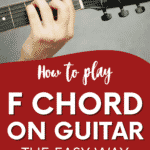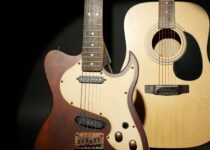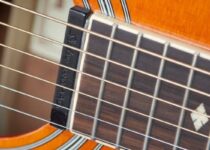The F barre chord is notoriously difficult for beginners to play. Just when you thought you were starting to master chords, the F chord shows up, and the cycle of buzzing strings, painful wrists, and sore fingers repeats.
But there are a few easier ways to play a modified F chord. You can:
- Use three notes in a similar shape to a C chord
- Make a “mini barre chord” by only barring the top two strings
- Play an F7 instead
If you’re looking at how to play F chord on guitar, (with or without using barre chords) then you’re in the right place. In this article, we will be taking a look at some exercises to help you warm up for the F chord, some easier ways to play it, and a few mistakes that beginners make (and how to counter them).
Hopefully, by the end of this lesson, you will start to master the F guitar chord and advance with your guitar playing.
Post Contents
Recommended Background Knowledge for This Lesson
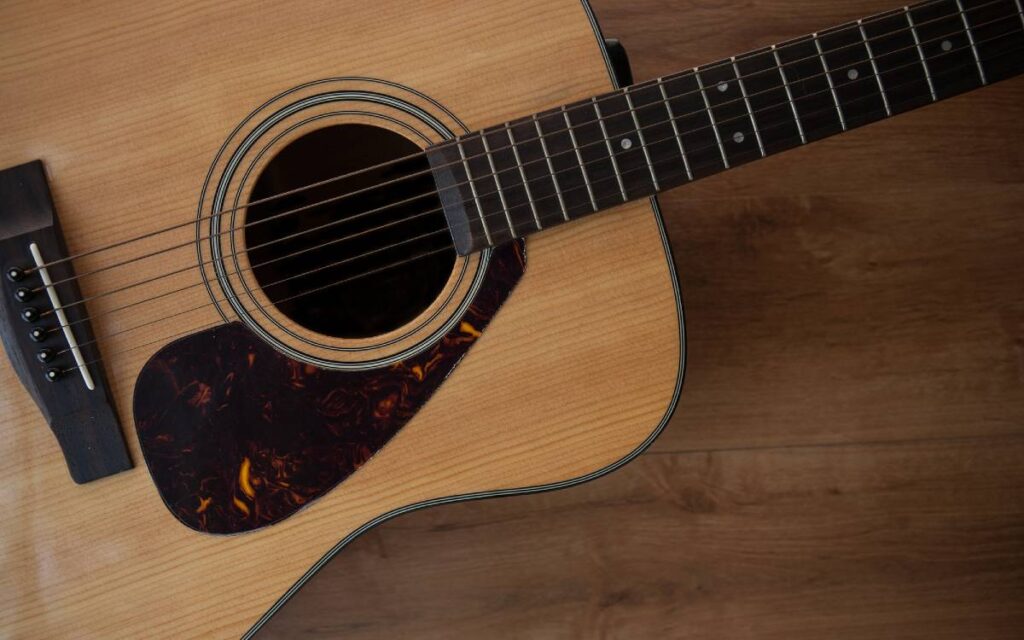
Assuming that you’re learning to play the guitar, it’s crucial that you are already familiar with your guitar first. Learn the names of the strings, the basic open chords, and a few easy guitar songs.
Knowing your way around the fretboard allows you to seamlessly transition between various chord shapes, and to learn new ones. So learning your fretboard is crucial.
It’s also helpful to learn some of the basic beginner chords before attempting to play the F chord. Almost every song comprises some sort of chord progression, so start learning chords and common chord progressions.
We recommend starting with Em, C, G, A, Am, and D chords first and slowly working your way up. It’s all well and good to learn to play an F chord, but you also need to practice transitioning to other chords.
Make sure your guitar is in standard tuning, and let’s get started with this guitar lesson.
How to Play F Chord on Guitar
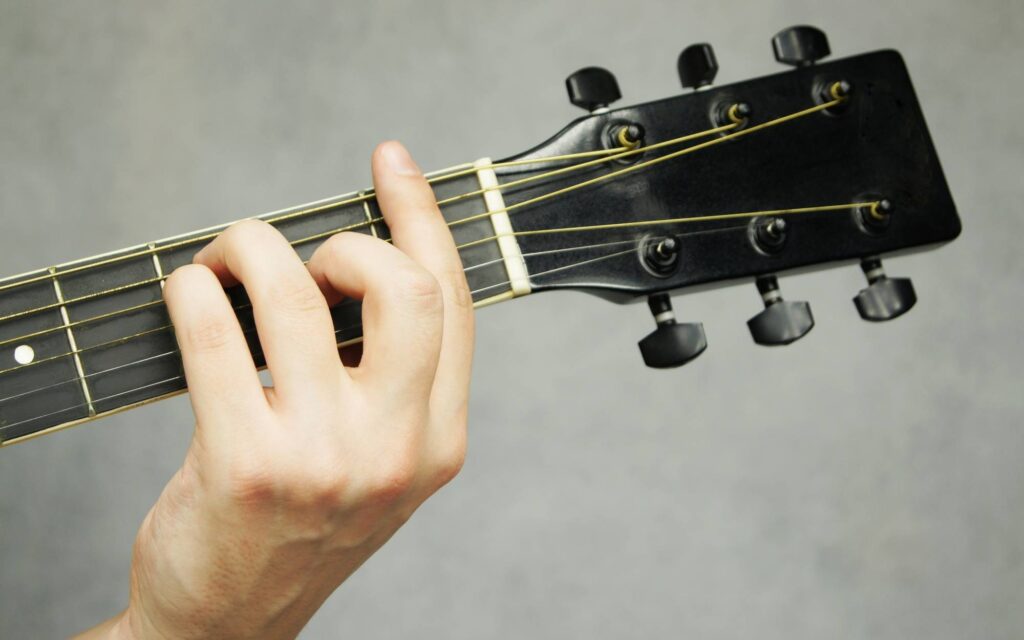
The F chord is notoriously tough to play. So much so that many beginning guitarists avoid it altogether. However, the harsh truth is that if you want to learn the guitar, you need to learn to play the F chord. Not only is it a vital chord in a lot of songs, but it will help you to learn other barre chords too.
In the following sections, you will learn some warm-up exercises and techniques to help wrangle the F barre chord (and barre chords in general), as well as some variations you can use in the meantime.
Everyone is different, and people learn at different paces. Some people may be able to pick up the “real” F chord instantly, while some people may need hours of practice before they can play it without a modified chord shape.
One of the more formidable challenges of learning the F chord is its barring aspect. We will talk about this later in the article but right now, let’s focus on warming up for the F chord.
Warming up for the F Chord
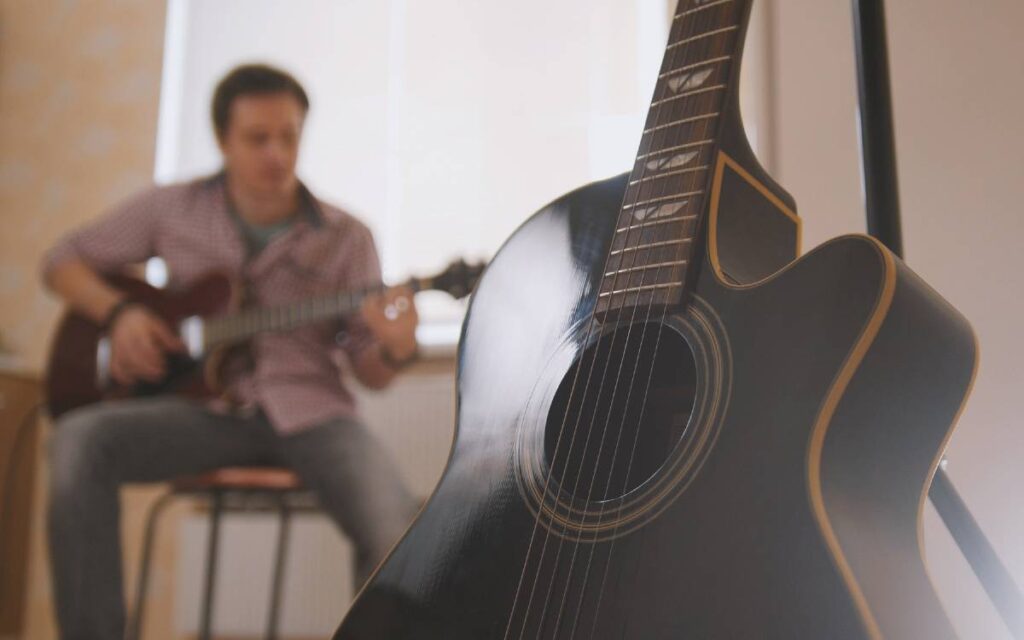
The F chord needs extensive use of the index finger. As this finger stretches across all six strings, you must ensure it’s strong and limber.
Through this exercise, you’re going to do three things. These are:
- Get your finger comfortable with the pressure of the strings of your guitar
- Discovering the best contact points on the index finger (it’s different for everyone)
- Experiment with the placement of the index finger
When you first place the index finger across the six strings on the first fret, roll your finger just a bit, so you are playing with the outer part of your finger. Remember, you may have trouble making contact with the string if you have soft pads on your fingers.
While you do the exercise, make sure to test out new finger placements and try to find something you feel comfortable with.
While it’s essential to focus on the strength of your index finger, the main goal of doing this exercise is to find a way to extend your index finger across all the strings in a way that feels comfortable.
Try picking each string, some of them will buzz horribly. And that’s okay – we’re still finding your optimal finger placement.
Warming Up Exercise

Use the index finger as if it were a button by applying and releasing pressure. Put your finger across all six strings.
Apply pressure on the low E string and pluck it. Now without moving the index finger, feel yourself apply pressure on the A string and pluck it. Keep doing this exercise for all six strings by using pressure on the string and plucking it.
We suggest repeating this exercise a few times so you can understand how much pressure you need to barre on all the strings. Move up the fretboard while repeating this exercise one fret at a time.
As you advance on the fretboard, you will realize that it gets harder to barre across the strings. This is because the length between frets decreases.
Keep doing this exercise a few times till you start feeling content and confident with your finger placement.
If the strings buzz, change up the angle of your finger and try again until every string rings out when you play it.
Playing the F Chord
To make the process of playing the F chord as painless as possible, let’s start with the more accessible variations before moving on to the barre version that everyone is scared of.
Version 1: Three-Note Chord
This version is easier to start with as it sits in the middle range of your guitar and won’t require too much strength or tricky fingering methods. It’s pretty similar to the C Major chord.
You can play it by putting your index finger on the 1st fret of the 2nd string. Put the middle finger at the 2nd fret of the 3rd string and the ring finger on the 3rd fret of the 4th string. Now strum the three strings down from the D string.
Once you start feeling comfortable with this three-note version, proceed to the second version.
Version 2: The High E String (Mini Barre Chord)
This version is very similar to the first one, the critical difference being that this version uses a mini barre across the first two strings using your index finger. You may be able to see this as a mini version of the full barre chord.
Start by putting your index finger on the 1st fret of the 1st and the 2nd string. Put the middle finger on the 2nd fret of the 3rd string and put the ring finger on the 3rd fret of the 4th string.
Once you are comfortable with this, you’re ready to progress on the final full barre chord.
Version 3: F Major Chord
What differentiates this from the previous versions is the fact that this chord requires you to use your index finger across all six strings. Also, the fact that the fret is close to the headstock makes it harder to apply pressure over long periods of time. The sound is often tough to produce, as the strings don’t ring out properly.
Use your index finger to apply pressure on all the strings on the 1st fret. Now put the middle finger on the 2nd fret of the 3rd string and your ring finger on the 3rd fret of the 5th string. Then put the pinky finger on the 3rd fret of the 4th string.
You can also try another variation of the same F barre chord by playing it in the 8th position. Place your index finger on the 8th fret of the 1st and the 5th string. Place the middle finger on the 10th fret of the 4th string and the ring finger on the 10th fret of the 3rd string. Finally, place your pinky finger on the 10th fret of the 2nd string.
Songs that Use the F Chord
From rock to country songs, you find the F chord being used everywhere. Here are a few songs that use the F chord.
- Another Brick in the Wall Pt.2 – Pink Floyd
- A Thousand Miles From Nowhere – Dwight Yoakam
- Can’t Feel My Face – The Weeknd
- La Bamba – Richie Valens
- Like I’m Gonna Lose You – Meghan Trainor
- Rolling In The Deep – Adele
- The Monster – Rihanna, Eminem
- With Or Without You – U2
Tips and Suggestions
Building Finger Strength
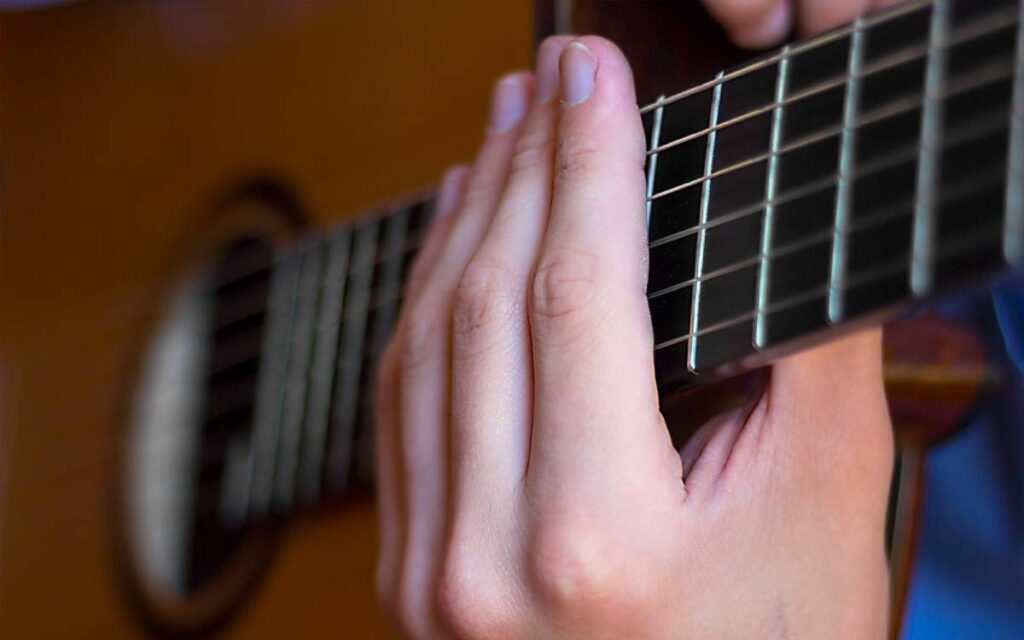
If you can, try playing the full barre chord on an electric instead of an acoustic guitar. This is because electric guitars have lower string tension and will be easier on your fingers and wrists, so you can just focus on the finger placement without worrying about buzzing strings.
If you’re looking for alternate ways to increase your finger strength and are looking to buy one of those finger-strengthening machines, please don’t! Just practice more. Instead, do your workout on your guitar. Not only does it improve your guitar skills, but it will also work wonders for your hand-eye coordination.
Remember to stop as soon as you experience pain in your wrists, though.
Building Muscle Memory
There is a simple exercise you can do to help develop your muscle memory. Start by placing your fret hand on your thigh, away from the fretboard. Now slowly count down from five, move your fret hand to the fretboard, and perform the F chord.
In the beginning, you may have trouble doing it in five seconds. If so, you can change the time interval to seven or ten seconds. As you start feeling comfortable, you can change the time interval to four or three seconds too.
Fixing Buzzing Strings

When you first start playing the F chord, you might notice that the B string is buzzing. This is because there isn’t enough arch in the middle finger, or the index finger isn’t putting enough pressure on the barre chord.
Arching your fingers is crucial as it prevents joint injury while having you play with the tips of your fingers.
Play for 15 minutes at least every day to build finger strength. This is a great way to make progress and practice to become one of the greatest guitar players!
Nailing the F Chord

The F chord has a reputation for being tough for beginners, and it’s well deserved. It requires strength and coordination, but there is no need to jump into it headfirst. Start with simple versions and level up as you go by following the guide we provided.

